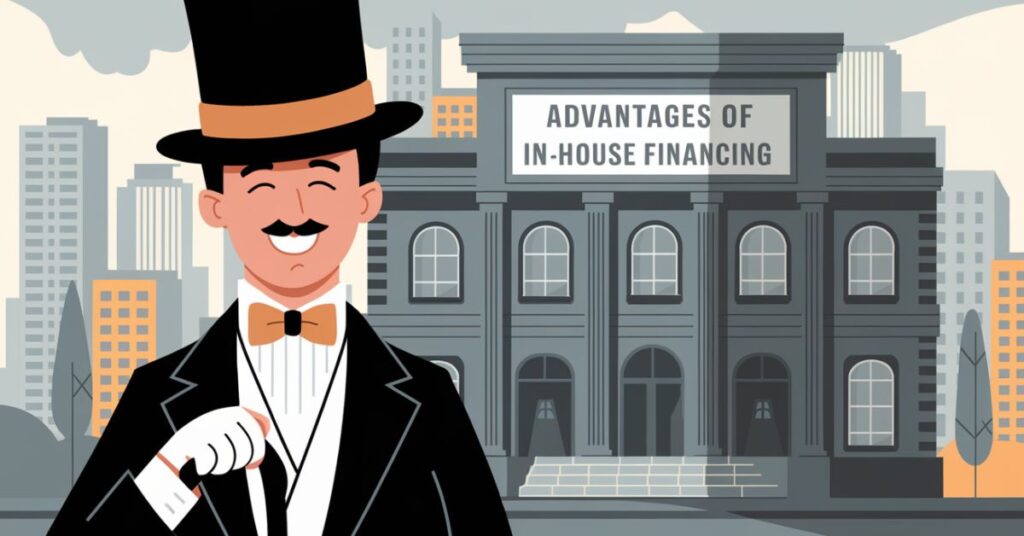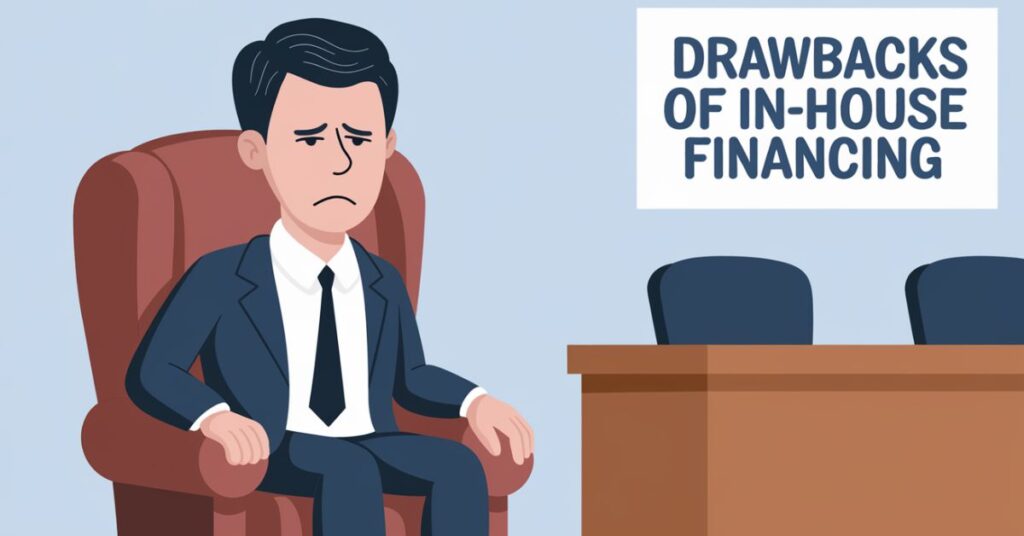Making big purchases often comes with a fair share of anxiety, especially when it comes to figuring out how to pay for them. In-house financing has emerged as a powerful option, offering flexibility, convenience, and specialized solutions to cater to a variety of financial needs. Whether you’re buying a car, new furniture, or funding a medical procedure, in-house financing can be your secret weapon for getting the best deals without the hassle of traditional loans.
In this post, we’ll dive into in-house financing options, the approval process, pros and cons, real-world applications, and tips on how to navigate this financing option to your advantage.
What is In-House Financing?
In-house financing refers to loans or payment plans offered directly by a retailer, dealership, or service provider, rather than through a third-party lender like a bank or credit union. This financing option allows the business to finance your purchase internally, making the process more streamlined and convenient.
Unlike traditional loans from a bank, in-house financing often comes with fewer hurdles in terms of credit checks and approvals, making it an attractive option for people with low credit scores or no credit history at all. However, it’s important to understand both the advantages and pitfalls before opting for this route.
Read related blog: Pedro Vaz Paulo – Your Trusted Guide to Unparalleled Business Success in the USA
Advantages of In-House Financing

Easier Approval Process
One of the biggest draws of in-house financing is the easier approval process. Because you’re dealing directly with the business offering the product or service, there’s often more flexibility when it comes to credit requirements. Many in-house programs are designed to cater to individuals with bad credit or no credit history, making it easier to get approval.
In contrast, traditional loans from banks or credit unions involve rigorous credit checks and may require a higher credit score for approval.
Convenience of One-Stop Shopping
The convenience of in-house financing cannot be understated. Instead of dealing with third-party lenders, you can get financing directly from the company you’re purchasing from. This saves time and simplifies the process since everything from the purchase to the loan approval happens in one place.
For example, if you’re buying a car through Ford Credit, you can handle the financing right at the dealership without the need for external loan approvals.
Specialized Offerings and Flexible Terms
Since businesses offer tailored financing options, they have the flexibility to structure loans based on customer needs. This could include flexible repayment terms, lower down payments, or even no interest during promotional periods.
Retailers often roll out financing promotions for big-ticket items like furniture or electronics. For instance, Home Depot’s Project Loan Program offers flexible terms for home improvement purchases, giving you up to 84 months to pay it off.
Exclusive Offers and Promotions
Many businesses offer exclusive deals and promotions that you won’t find elsewhere. These promotions often include zero-interest for a set period, no down payment options, or bundled warranties.
For example, Toyota Financial Services frequently offers promotions for new car buyers, including low-interest or no-interest payment plans. Similarly, medical financing providers like Cosmetic surgery financing services offer special rates for elective procedures that may not be covered by insurance.
Drawbacks of In-House Financing

While in-house financing offers plenty of benefits, it’s not without its downsides. Before diving in, it’s essential to understand some of the risks associated with this type of financing.
Higher Interest Rates
In-house financing can come with higher interest rates compared to traditional loans from banks or credit unions. Businesses offering in-store financing often charge a premium for the convenience and flexibility they provide. As a result, the overall cost of the purchase may end up being significantly higher in the long run.
For instance, some furniture financing deals may offer zero interest for a promotional period but switch to a much higher rate afterward if you fail to pay off the balance.
| Financing Type | Interest Rate | Approval Process |
| In-House Financing | 5-30% (varies widely) | Easier, flexible |
| Traditional Bank Loans | 3-10% | Stricter, more hurdles |
| Credit Union Loans | 2-8% | Moderately strict |
Limited Loan Options
Unlike traditional loans, in-house financing typically offers limited loan options. Banks and other third-party lenders may offer a variety of loan products to suit different financial needs, but in-house financing usually comes with rigid structures and limited flexibility in how the loan is structured.
Potential for Predatory Practices
While most businesses offer in-house financing in good faith, there is always the risk of encountering predatory practices. Some companies may offer financing options with hidden fees, high late payment penalties, or impossible repayment terms. It’s important to thoroughly read the loan agreement to avoid falling into such traps.
Temptation to Overspend
The ease and convenience of in-house financing can sometimes lead to overspending. When you’re not required to put down a significant amount of money upfront, it’s easy to fall into the trap of buying more than you can afford.
For example, in the automotive industry, buyers may opt for a more expensive car than they need, simply because GM Financial or Ford Credit makes it easy to get approved for a higher loan.
Real-World Applications of In-House Financing
Automotive Financing
The automotive industry is one of the largest sectors for in-house financing. Major automakers like Ford Credit, GM Financial, and Toyota Financial Services offer financing options directly through their dealerships. These programs are designed to make it easier for customers to purchase new or used cars without going through external lenders.
For example, Toyota Financial Services frequently runs promotions for qualified buyers, offering low or no-interest loans for a specified period.
Retail Financing: Electronics, Furniture, and Home Improvement
Many retailers offer in-store financing for big-ticket items like electronics and furniture. Retailer financing programs, like Home Depot’s Project Loan Program, allow customers to finance home improvement loans with extended payment plans.
| Retailer | Financing Program | Typical Terms |
| Home Depot | Project Loan Program | Up to 84 months, competitive rates |
| Best Buy | In-store Financing for Electronics | 12-24 months, 0% interest promos |
| IKEA | Furniture Financing | 6-36 months, special offers |
Medical and Dental Financing
Medical financing is another area where in-house financing plays a critical role, especially for elective procedures that aren’t covered by insurance. This includes services like cosmetic surgery financing, orthodontic treatment plans, and even dental procedures like implants or braces.
Providers often offer flexible loan terms to accommodate the high costs of these procedures, making it easier for patients to afford treatments over time. However, higher interest rates and the risk of hidden fees make it crucial to carefully review the terms of the loan before committing.
Buy Now, Pay Later: The New Face of In-House Financing
With the rise of buy now, pay later platforms like Affirm and Klarna, point-of-sale financing is gaining popularity. These platforms allow consumers to split their purchases into smaller, more manageable payments. Though technically not in-house financing, many businesses partner with these services to offer their own branded buy now, pay later options.
For example, large retailers like Home Depot and Best Buy now offer point-of-sale financing to make big purchases more affordable.
Is In-House Financing Right for You?
Determining whether in-house financing is the right option for you depends on several factors, including your financial situation, credit score, and the nature of the purchase.
Assessing Your Financial Health
Before opting for in-house financing, take a good look at your financial health. Ask yourself:
- Can I afford the monthly payments?
- Is my credit score good enough to qualify for better terms elsewhere?
- Are there any prepayment penalties or hidden fees in the agreement?
Questions to Ask Before Committing
Always ask the right questions before signing on the dotted line:
- What is the interest rate after any promotional period?
- Are there any processing fees or loan origination fees?
- What happens if I miss a payment?
Comparing In-House Financing to Traditional Loans
While in-house financing offers convenience and ease of approval, traditional loans from banks, credit unions, or even personal loans often come with lower interest rates and more flexible terms. It’s crucial to compare both options carefully.
Tips for Getting the Best Deal on In-House Financing
- Do Your Homework: Research multiple financing options before making a final decision. Compare rates from Ford Credit, GM Financial, and other industry-specific lenders.
- Negotiate Terms: Don’t hesitate to negotiate. Terms like interest rates and down payments are often flexible.
- Read the Fine Print: Always review the agreement for hidden fees, prepayment penalties, or balloon payments that could increase the overall cost.
- Consider Alternatives: Look into personal loans, credit cards, or buy now, pay later platforms like Affirm or Klarna as potential alternatives to in-house financing.
Avoiding Common Pitfalls

Watch Out for Predatory Practices
Some in-house financing programs come with predatory terms. Be cautious of companies that pressure you into signing without fully understanding the terms.
Don’t Overspend
Just because you’re approved for a larger loan doesn’t mean you should use it. Stick to your budget and avoid making purchases you can’t comfortably afford.
The Future of In-House Financing
Technology and In-House Financing
The future of in-house financing will be shaped by technological advancements, particularly in the areas of mobile app loan approvals, AI-driven loan approvals, and blockchain integration. These innovations are already making it easier for consumers to get instant approval for loans, sometimes without even visiting a physical location.
Predictions for the Next 5 Years
As businesses continue to adopt new technology, the in-house financing landscape will likely become even more streamlined, with faster approvals, more flexible repayment options, and increased transparency in loan terms.
Must read: Sierra Mist Lawsuit: The Reason Why PepsiCo Replaced It With Starry
FAQs
How does in-house financing affect my credit score?
Making timely payments can boost your credit score, while late payments can have the opposite effect.
Can I refinance my in-house loan later?
Yes, you can often refinance through a traditional lender if you find a better rate.
What happens if I can’t make my payments?
Missed payments can result in penalties and negatively impact your credit score.
Are there hidden fees in in-house financing deals?
Always check for loan processing fees, origination fees, and potential prepayment penalties.
Is in-house financing available outside the US?
Yes, many international companies offer in-house financing options, but terms and conditions vary by country.
Conclusion
In-house financing is a valuable tool for consumers looking to make big purchases, offering flexibility, easier approvals, and the convenience of one-stop shopping. However, it’s essential to weigh the pros and cons, compare your options, and fully understand the terms before committing. With careful planning, in-house financing can indeed be your secret weapon for big purchases.







